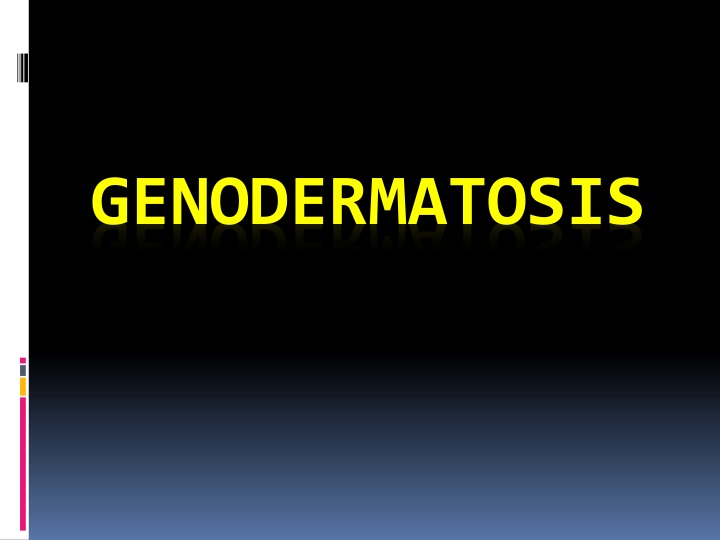
Dermatological Genetic Disorders Overview
Explore genodermatoses including neurofibromatosis, tuberous sclerosis, xeroderma pigmentosum, and ichthyosis. Learn about clinical features, skin findings, and inheritance patterns affecting the skin, bone, and nervous system.
Download Presentation

Please find below an Image/Link to download the presentation.
The content on the website is provided AS IS for your information and personal use only. It may not be sold, licensed, or shared on other websites without obtaining consent from the author. If you encounter any issues during the download, it is possible that the publisher has removed the file from their server.
You are allowed to download the files provided on this website for personal or commercial use, subject to the condition that they are used lawfully. All files are the property of their respective owners.
The content on the website is provided AS IS for your information and personal use only. It may not be sold, licensed, or shared on other websites without obtaining consent from the author.
E N D
Presentation Transcript
Neurofibromatosis NF is an autosomal dominant disorder that affects the bone, the nervous system, soft tissue, and the skin.
Clinical features 1-Caf au lait spots . brown macules. develop during the first 3 years of life . 5 or more greater than 0.5 cm in diameter are suggestive of NF. 2-Lisch nodules are pigmented hamartomas of the iris 3-Axillary freckling diagnostic feature in NF 4-Neurofibromas benign tumor of NF.They can develop along a nerve. Bone involvement : kyphoscoliosis, pseudoarthrosis neurologic abnormalities deafness , seizures Endocrinologic problems . Short stature and growth hormone deficiency
Tuberous Sclerosis autosomal dominant epilepsy, mental retardation, and adenoma sebaceum
Skin findings 1- adenoma sebaceum, is cutaneous hamartoma .(angiofibroma),clusters of yellowish-pink papules,located mainly on nasolabial fold,cheek& chin 2- hypomelanotic (ash leaf) macules :earliest sign,present at birth 3 Shagreen patch . soft, flesh-colored to yellow plaques with an irregular surface ,appears most commonly in the lumbosacral region. 4-Periungual fibroma : appear at or after puberty in approximately 50% of cases. They are smooth, flesh-colored, conical projections that emerge from the nailfolds of the toenails and fingernails
Xeroderma Pigmentosum (XP) Autosomal recessive Defective DNA excision repair mechanism after exposure to UV light, sever photosensitivity, freckling & skin cancers before the age of 10 years. Ocular abnormalities included ectropion,photophobia, corneal opacity. Progressive neurological degeneration hearing loss, spasticity, ataxia, polyneuropathy, mental retardation
Ichthyosis group of skin disorders characterized by an excess accumulation of cutaneous scale, Ichtyosiseither congenital or acquired. congenital: 1-Dominant ichthyosis vulgaris (DIV) 2-X-linked recessive ichthyosis (XLI) 3-Lamellar ichthyosis (LI) 4-Epidermolytic hyperkeratosis (EH)
Ichthyosis vulgaris Most common, auto. Dominant, onset usually at puberty, excessive dryness (xerosis) & scales on trunk & limbs but sparing the flexures, no significant ocular findings, The condition tends to improve with age ,frequently associated with atopy,
Acquired ichthyosis usually in adults as small, white, fine scales that seen mainly on the extremities 1- internal neoplasia (eg, Hodgkin lymphoma, leukemia), 2-systemic illness: sarcoidosis, hypothyroidism, chronic hepatitis, malabsorption , bone marrow transplantation, 3- infection: HIV, leprosy 4- drugs: nicotinic acid, statins,
